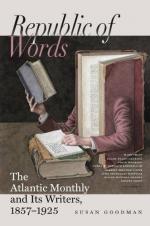When we had last heard of Annesley Hall, it was ruinous and desolate, and we knew not in what condition it might now be found. Passing through an avenue of ancient oaks, the road winds down to an old picturesque gate-house, and, leaving the carriage, we walked onward. Looking through the arch of entrance, we saw as in a picture, nay, as in the poet’s dream, “the venerable mansion,” sitting quietly in autumn sunshine on its old terrace. To gray walls and peaks clung a climbing plant, its leaves red with touch of frost, contrasting deliciously with green ivy, and putting a bit of color into darker hues of stone-work. As we passed beyond the gate, we saw that the mansion had been, restored and repaired by careful hands guided by tasteful eyes and loving hearts. Above the hall-door was a bay-window, which instinct told us belonged to the “antique oratory,” but we walked onward to the terrace, with its stone balustrade, inclosing a bright flower-garden. On the other side of the house stretches the lawn and park, with deer feeding quietly in the distance. No human form appeared; all was silent and peaceful. We walked thoughtfully on the old terrace, recalling the images of the poet and the Lady of Annesley; but looking up at the ancient sun-dial on one of the gables, we perceived that its shadow fell deeper and deeper with the declining day, telling us, as it had told many before, how time waited not, and reminding us that we, also were travellers. Passing again round the mansion, and casting a wistful look within, we saw a woman sitting at a low window, sorting fruit. We approached, and asked if strangers were permitted to see the Hall. She replied gently, that it was not “a show-house.” We pleaded our cause successfully, however, when we told her how the thought of Mary Chaworth had led us here from a distant land. If the owners of Annesley knew that once an exception was made to a general rule, we trust they also believed that the visitors were not actuated by an idle curiosity.
Our request being granted, our guide laid aside her plums, and with a kind hand admitted us into the entrance-hall. It was low and venerable, with family-portraits on the walls, among them that of the Mr. Chaworth whom the “wicked Lord Byron” of other days shot in a duel. From the hall we entered the modern part of the house, harmoniously blended with the older portion of the building. In the drawing-room, two noble portraits by Sir Joshua Reynolds arrested our attention. The lady (as Miss Burney tells us in her journal) was a beauty and a belle of Sir Joshua’s time, and the painter has done justice to his subject, who is drawn at full length, feeding an eagle,—a spirited, splendid woman, who looks down from the canvas with bright, triumphant eyes. In the next apartment we were shown a portrait which touched deeper chords in our heart. It was a likeness of Mary Chaworth in miniature, representing a mature and beautiful woman.
“Upon her face there was a tint
of grief,
The settled shadow of an inward strife,
And an unquiet drooping of the eye,
As if its lids were charged with unshed
tears.”




